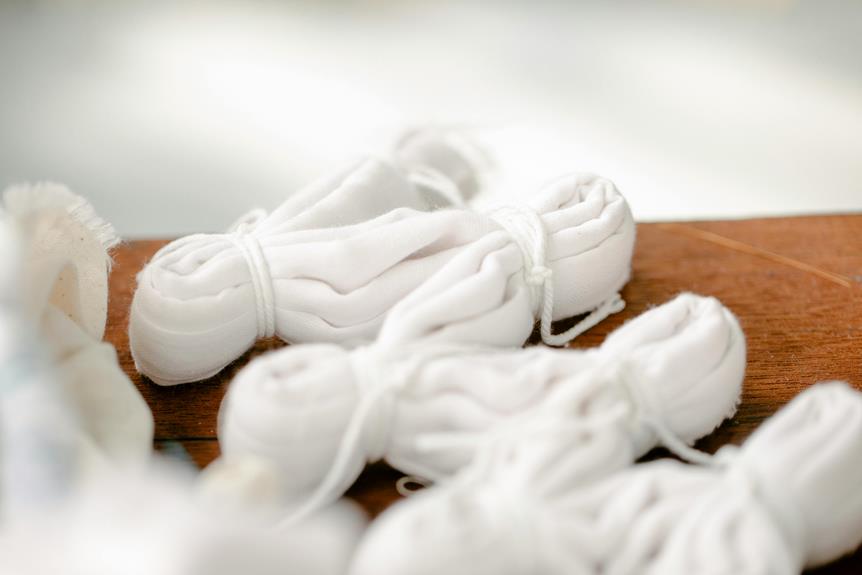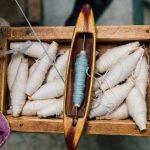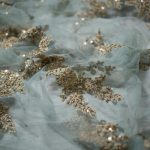When you're working with gossamer fabrics, the right sewing techniques are crucial to maintaining their delicate beauty. It's important to choose fine Microtex needles and lightweight threads, but there's more to it than just that. You'll also want to pay attention to your machine settings and handling methods to avoid damage. Exploring techniques like French seams or rolled hems can yield impressive results, but knowing precisely how to execute them can make all the difference. Wondering what specific adjustments you'll need to ensure success?
Table of Contents
Choosing the Right Needle
When choosing a needle for gossamer fabrics, opt for a fine needle to ensure you glide through the delicate material without causing damage. A size 60/8 or 70/10 needle is ideal for these lightweight textiles, as it minimizes the risk of snagging or tearing.
Needles with a sharp point are essential since they penetrate the fabric cleanly, creating minimal disturbance to the fibers. You'll want to avoid using heavier needles, as they can create large holes that ruin the fabric's soft appearance. If you're working with particularly sheer gossamer, consider a microtex needle, which has a slender, tapered point designed specifically for precision on fine materials.
Always test your needle choice on a scrap piece first; this allows you to gauge its performance without jeopardizing the main project. If you notice any skipped stitches or fabric pull, it might be time to switch to a different size or type.
Optimal Thread Selection
Choosing the right needle sets the stage for optimal thread selection, as your thread needs to complement the delicate nature of gossamer fabrics. When you're working with such sheer materials, the type of thread you choose can greatly affect the outcome of your project.
Consider these factors when selecting your thread:
- Weight: Go for a lightweight thread, like 60-weight or finer, to maintain the fabric's airy texture.
- Material: Opt for polyester or nylon threads, as they're strong yet flexible, perfect for resisting breakage while sewing.
Pinning and Handling Techniques
Effective pinning and handling techniques are crucial for preventing gossamer fabrics from slipping and shifting during the sewing process.
Start by using fine, sharp pins specifically designed for lightweight fabrics. These pins minimize holes and won't weigh down delicate gossamer like standard pins might. When you pin, insert the pins perpendicular to the edge of the fabric. This allows you to easily remove them as you sew without interfering with your stitching line.
Consider using just enough pins to hold the materials together without overcrowding. Placing pins about every 2-3 inches ensures the fabric remains stable while allowing you to work comfortably. For curved edges, you might need more frequent pinning, adjusting the spacing based on the fabric's behavior.
Handle gossamer gently, avoiding any sudden pulls. When lifting your piece, support the fabric entirely with your hands rather than dragging or tugging at sections.
You can also use fabric weights instead of pins for sensitive areas, providing even less chance of distortion.
With these pinning and handling techniques, you'll manage gossamer beautifully, ensuring a precise and elegant finished product.
Sewing Machine Settings
Setting your sewing machine correctly is essential for working with gossamer fabrics to achieve smooth and even stitches. Since gossamer is lightweight and delicate, you need to customize your machine settings to avoid damaging the fabric or creating puckers.
First, adjust your stitch length to a longer setting. A longer stitch helps to minimize the risk of tearing, allowing the fabric to flow gracefully without snagging.
Next, use a fine needle, such as a size 60/8 or 70/10, specifically designed for lightweight fabrics. This will help avoid unintended holes in the fabric while delivering precise stitches.
Lastly, select a straight stitch for most seams. A few additional settings to keep in mind include:
- Tension: Lowering the thread tension will help to accommodate the delicate fibers, preventing them from stretching out of shape.
- Feed Dogs: You might want to use a walking foot to ensure even feeding of the fabric layers.
Finishing Edge Techniques
After mastering the sewing machine settings for gossamer, you can enhance your project by focusing on finishing edge techniques that prevent fraying and provide a polished look.
One effective method is the French seam, which is ideal for lightweight fabrics. To create this seam, sew your raw edges together with a narrow seam allowance, trim, then fold the fabric, enclosing the raw edges, and sew again. This not only secures the edges but adds a delicate finish.
Another option is to use a zigzag stitch or a serger, which works well for curved edges. The zigzag stitch allows the edges to stretch slightly while securing them, preventing fraying. If you own a serger, it can effortlessly finish edges with a clean, professional look.
Bias tape is fantastic for sealing edges too. Simply attach it to the raw edge, pressing it into place for an elegant detail.
Don't forget to consider a rolled hem, which creates a subtle, lightweight finish that works perfectly with gossamer fabric. By applying these techniques, you'll elevate your sewing project, ensuring it's beautifully finished and ready for wear.
Frequently Asked Questions
Can I Hand Sew Gossamer Fabrics Effectively?
Yes, you can hand sew gossamer fabrics effectively! Just use a sharp needle, fine thread, and take small, delicate stitches. Practice your technique to ensure your seams remain secure without snagging the delicate fibers.
What Types of Stitches Work Best With Gossamer?
When sewing gossamer, you'll want to use fine, lightweight stitches like a basting stitch or a straight stitch. These techniques minimize fabric distortion and ensure your delicate material maintains its beautiful, airy quality.
How Do I Prevent Gossamer From Fraying?
To prevent gossamer from fraying, you can employ a zigzag stitch along the edges or use bias tape. Applying a fabric sealant or fray check also helps keep those delicate fibers intact and manageable.
Are There Specific Patterns for Gossamer Projects?
Yes, there are specific patterns designed for gossamer projects. Look for lightweight, flowing designs that accommodate delicate fabrics. You'll want to choose patterns with minimal seams and ease of movement to prevent stress on the material.
Can I Wash Gossamer Items After Sewing?
Yes, you can wash gossamer items, but it's best to hand wash them gently in cold water. Avoid harsh detergents, and always air dry to maintain the delicate nature of the fabric.
- How Does Ring Spun Cotton Affect Garment Fit and Shape Retention? - August 13, 2024
- What Are the Challenges in Producing Ring Spun Cotton? - August 13, 2024
- Is Ring Spun Cotton Suitable for Plus-Size Clothing? - August 13, 2024







